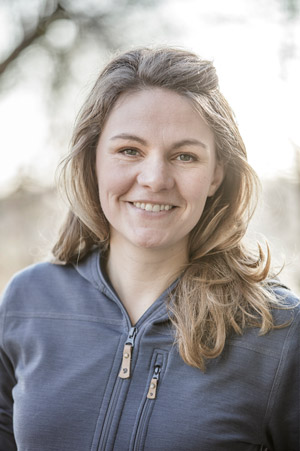Eco-Shell
Six questions to Christiane

Why does Fjällräven want to avoid fluorocarbons?
“Perfluorinated substances are a type of compound that are both oil and water resistant and are therefore used in many different ways, for example for impregnating leather and textiles. They accumulate in living organisms and are toxic. Even if toxicity was only a risk, it would be enough for us to stop using them.
We always adopt the precautionary principle; we want to avoid all types of damaging chemicals and we have strict restrictions and demands for our suppliers.”
What does fluorocarbon-free impregnation mean for the products – is it less effective or less waterproof?
“Fluorocarbon-free impregnation is also water resistant, so our products are absolutely no worse off for it. If you look at our products’ area of use – outdoor life – then fluorocarbon-free impregnation totally fulfils functionality demands. It is, however, not as resistant to oil as treatments with fluorocarbons.
It also needs to be renewed a little more often – about every second time you wash it. We think that the little extra effort needed here is worth it to get rid of these dangerous substances.
We have to remember that waterproofness has nothing to do with impregnation, it is achieved in other ways; for example in Eco-Shell it is the membrane that makes the garments waterproof.”
It has taken several years to convert to using fluorocarbon-free impregnation. Why has it taken so long?
“We needed to test the new alternatives so we could be sure that they fulfil the demands we have on functionality. This always takes time. In addition, a lot has happened in the market in recent years, there are many more alternatives available now. We also want to be totally sure that the alternatives really are better sustainably as well as having good functionality.”
Can you be sure that there won’t be any fluorocarbons found if the fabrics are tested?
“Because these dangerous substances are still being used far and wide, even in our branch, it is impossible to guarantee that there won’t be any traces of fluorocarbons found in our products. There is a risk that they might be cross-contaminated during production, transportation or in retail stores.”
How do I re-impregnate a jacket that has fluorocarbon-free impregnation?
“You can choose a fluorocarbon-free spray impregnation, such as PFC-free Waterproofing Impregnation that we have developed specifically for Eco-Shell.”
I have an older shell jacket, should I throw it away now?
“No absolutely not – the environment will not benefit from you throwing away a perfectly functional jacket. The best thing you can do is to use it for as long as possible and then let it go to someone else who needs it.”
為什麼Fjällräven想要避免使用碳氟化合物?
“ 全氟化物質是一種既抗油又抗水的化合物,因此有多種使用方式,例如用於浸漬皮革和紡織品。它們在生物體中積累並且是有毒的。即使毒性只是一種風險,以足以讓我們亦停止使用它們。
我們始終採用預防原則;我們希望避免所有類型的有害化學品,我們對供應商有嚴格的限制和要求。”
無碳氟化合物浸漬對產品的意義是什麼 - 效果較差或防水性較差?
“ 不含氟碳的浸漬也具有抗水性,因此我們的產品絕對不會變得更糟。如果您看看我們產品的使用領域 - 戶外生活 - 那麼無碳氟化合物浸漬完全滿足功能需求。然而,它不像含碳氟化合物的處理那樣抗油。
它還需要更頻繁地更新 - 大約每使用兩次洗一次。我們認為,為了擺脫這些危險物質,這裡需要的額外努力是值得的。
我們必須記住,防水性與浸漬無關,防水特性是通過其他方式達成的;例如,在 Eco-Shell中,使衣服防水的是薄膜。”
轉換為使用無碳氟化合物浸漬需要幾年時間。為什麼需要這麼長時間?
“ 我們需要測試新的替代品,以便我們確保他們滿足我們對功能的要求。這總是需要時間。此外,近年來市場上發生了很多變化,現在還有更多的替代品可供選擇。我們還希望完全確定替代方案確實具有更好的可持續性以及良好的功能。”
如果布料經過測試,您能否確定不會發現任何碳氟化合物?
“ 因為這些危險物質仍然被廣泛使用,即使在我們的分支機構中,也不可能保證我們的產品中不會發現任何碳氟化合物的痕跡。在生產,運輸或零售店中存在交叉污染的風險。”
我如何重新浸漬無碳氟化合物浸漬的外套?
“ 您可以選擇不含碳氟化合物的噴塗浸漬,例如我們專為Eco-Shell開發的不含碳氟化合物(PFC-free)防水浸漬劑。”
我有一件舊的外套,我現在應該扔掉嗎?
“ 絕對不要 - 環境不會從您扔掉一件功能齊全的外套中受益。您能做最好的是盡可能長時間地使用,然後轉讓給其他有需要的人。”



